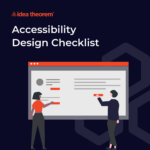Dashboard designs have increased in importance over the years, as enterprises use them to see crucial information at a glance before taking any action. A well-designed dashboard shows heavy data in a simple and intuitive way.
The information it can present could be from the latest trends, updates to your products, or your company. A dashboard is a place where the user can take quick actions or navigate to various areas of the application for a detailed view.
At Idea Theorem™, we have had the opportunity to work on various enterprise projects consisting of intranets, HR Portal, Cost management tools, and SAAS platforms. Along the way we have built several dashboards, here we have put together guidelines to help you design a great dashboard UX.
Armed with a powerful collection of information, businesses can make faster decisions based on information available in a visual and concise manner. A good dashboard design means:
- Information available at the fingertip
- Metrics are clear
- Intuitive design
- Customizable
- Summarized data
Dashboards can be a daunting task to design, especially, if you don’t have enough information to create a basis for designing the dashboards. Creating a user journey map first will definitely help you understand the journey or touchpoints that the user goes through to complete the task or tasks and the important information that needs to be displayed on the dashboard UI.
A lot of people think that the dashboard is an entire website but in truth, it is one part of the website where the information is summarized and shown to the user. The users can take action there or go to a more detailed page to get more information.
There are several types of dashboards:
- Key Performance Indicator (KPI) Dashboards
- Business Intelligence Dashboards
- Analytic Dashboards
- Productized Dashboards
Dashboard design guidelines
1. Know your Audience
Great dashboard UX is created when you know the target audience. A dashboard view for the manager will be different from the team member’s view. It is important to know what kind of data the targeted users will be interested in or what is their level of expertise. Doing some user research will help you understand your users.
2. Choose the right kind for data visualization
Choosing the right kind of visual to showcase the data is very important for a well-designed dashboard. If incorrect visualizations are chosen, then there is a high possibility of missing the concept of a user-friendly dashboard design. It is crucial to learn what type of data needs to be shown to the user in a manner that tells the story of the entire data set.
Knowing your audience will help in determining what data needs to be provided to them. The following are commonly used data visualization types:
- Line Chart
- Bar Graphs
- Tables
- Pie Chart
- Scatter Chart
- Spatial Map
- Gauge Chart
- Area Chart

Types of Charts
Things to keep in mind:
- Avoid a variety of data visualization just for the sake of making it pretty.
- Avoid cluttering your charts with too much information and data labels. Avoid putting too much information on the dashboard. For example, try to keep only 3-4 key values.
- Don’t mix big and small measures together in the same graph. For example, if in one place you are using millions and in the other place, you are using hundreds.
- Keep the same measuring system. If you are using the metric system in your graphs and suddenly there are imperial system measures, it will confuse the users.
- Keep consistent naming conventions and date formats
- If you are using monetary value, keep the same currency all throughout the dashboard
- Truncate large values
3. Summarize data in 1 screen
Don’t overload users with a lot of information on one page. That is just going to make users confused. Dashboards have a tendency to become cluttered. This makes it harder for the user to focus on any particular table or chart. There would obviously be a time and place where different kinds of users will require more or fewer amounts of data, just ensure that relevant data is shown in an organized manner.
Things to keep in mind:
- Show summarized data instead of showing full data and give users the option to expand on it
- Show relevant data
- Use a progressive drill-down system to showcase information
- Repeated users do not require to see the same information again and again. Show them new information or the information which has changed by highlighting the changes
- Show users warnings and unusual patterns instead of showing the entire data set
4. Group related information together
The law of proximity states that objects that are near, or proximate to each other, tend to be grouped together. This law is useful by grouping together different clusters of content or data for users to view at a glance. This is also called Gestalt Laws of Grouping. These principles are organized into 5 categories: 1. Proximity 2. Similarity 3. Continuity 4. Closure 5. Connectedness.

5. Don’t overdo with colors
It is important to stick to a few colors. Too many colors can overload your audience visually and the users might not be able to focus on their task. Use intense colors to showcase your data to draw the user’s attention, using saturated colors will make users lose interest and might not be able to make the right analytical decision.
Things to keep in mind:
- Keep colors consistent all throughout the dashboard UI
- Use the same colors for the same items on all the charts
- Do not misuse traffic light colors. Keep red for warnings or errors, greens for good or done
6. Create an intuitive layout
One of the dashboard design best practices is displaying the most significant data on the top part of the dashboard, important information in the middle, and basic or general details at the bottom.
7. Show the right context
Showing the right context in dashboard design is very important. Context is in the form of text including:
- Labeling data visualization
- Headers
- Explanatory paragraphs
- Annotations
- Legends
Without context, dashboard designs are meaningless and difficult to understand. Context helps to add emphasis, guide the users to the right information and help them to analyze the data.
Final Thoughts
Dashboard design best practices stress consistency and minimalism. First, create personas through user research and then start working on wireframes and then start working on the design. UX plays an important factor and it defines how a dashboard will look and feel.
Want to learn more about Customer Personas?
Download our Template Here >>
—
What’s Next
Idea Theorem is an award-winning design & development agency based in North America. Through our empathy-driven approach, we have crafted digital products that have positively impacted over 10 million users. Our mission is to shape the digital future by delivering exceptional experiences. Contact Us if you have any questions; we will gladly help you.







